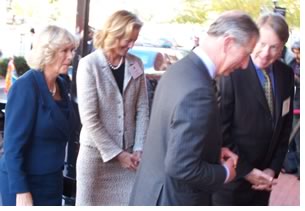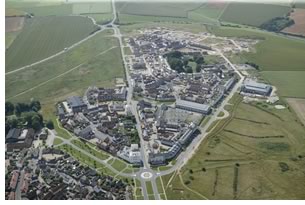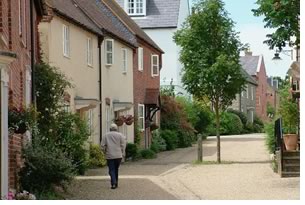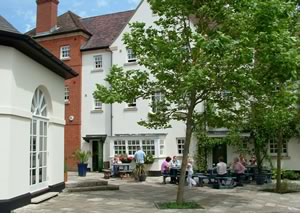

11/2005
by Douglas E. Gordon
Noting the time-honored principles of proportion and community, Prince Charles accepted the National Building Museum Vincent Scully Prize November 3 in Washington, D.C. In his first visit to the museum since the first AAF/AIA Accent on Architecture Gala in 1990, the heir to the British throne, accompanied by his wife, Camilla, the Duchess of Cornwall, proclaimed his admiration for “traditional urbanism.” Scully himself presented the award.
 The Scully Prize, established in 1999, recognizes exemplary practice,
scholarship, and criticism in architecture, landscape architecture, historic
preservation, or urban design. Previous recipients are Scully, the Aga
Khan, Jane Jacobs, Robert Venturi and Denise Scott Brown, and, in 2004,
Elizabeth Plater-Zyberk and Andrés Duany.
The Scully Prize, established in 1999, recognizes exemplary practice,
scholarship, and criticism in architecture, landscape architecture, historic
preservation, or urban design. Previous recipients are Scully, the Aga
Khan, Jane Jacobs, Robert Venturi and Denise Scott Brown, and, in 2004,
Elizabeth Plater-Zyberk and Andrés Duany.
Among the prince’s contributions, said National Building Museum Executive Director Chase Rynd, are his long-standing interest in the built environment and commitment to creating urban areas with human scale. In particular, the Prince’s Foundation for the Built Environment teaches the principles of traditional urban design that “accommodates the car while celebrating the pedestrian,” as Charles said in his acceptance speech. He referred specifically to Poundbury, an urban development of houses, cottages, shops, and light industry on the outskirts of Dorchester, Dorset, England, designed by Leon Krier.
 Plater-Zyberk lauds vision and commitment
Plater-Zyberk lauds vision and commitment
“His Royal Highness the Prince of Wales is the only recipient of
the Scully Prize so far who can be recognized for achievement in all the
endeavors described in the definition of the prize’s scope,” noted
Plater-Zyberk in her tribute. Twenty years after he first decried a proposed
Modernist addition to the National Gallery in Trafalgar Square as a “monstrous
carbuncle on the face of a much loved and elegant friend,” the prince
can look back with satisfaction on his intended effect, she said.
“He courageously maintained his opinion and set out to learn more about what he had intuited,” Plater-Zyberk said. “He sought out the counsel of great thinkers and writers such as Leon Krier and Christopher Alexander . . . Thus emerged the Prince of Wales Institute of Architecture—now the Prince’s Foundation—as well as the popular and educational BBC film, A Vision of Britain, and the book of the same name.”
Noting that Poundbury initially incited derision among architectural critics, Plater-Zyberk cited post-occupancy data that show it to be a success in every respect, “not least, a most gratifying increase in the level of human contentment.”
 In presenting the prize to HRH The Prince of Wales, Scully praised his
stalwart stand on “the best and gentlest traditions of land use
and human habitation.”
In presenting the prize to HRH The Prince of Wales, Scully praised his
stalwart stand on “the best and gentlest traditions of land use
and human habitation.”
“In the face of implacable opposition from some of the most vocal critics in Britain, and at the grave and constant risk of personal unpopularity, you have courageously revived, defended, and sustained the most humane principles of British and American architecture and town making,” Scully said.
Look to the past to inform the future
It’s time for a new way of thinking, Charles told the audience
of 1,000 at the National Building Museum who had come to see him receive
the Scully Prize. That new way, as Scully, Krier, Alexander, and Plater-Zyberk
have shown him, the prince said, is to adhere to traditional scale, context,
and proportion. There is a reason that certain forms of architecture
have been sustained throughout the centuries: they appeal to fundamental
and universal human values, Charles argued.
The creative challenge for architects and urban planners is to combine local environments with traditional urban design and contemporary needs. Especially as developing nations become more consumer-oriented and the demand for existing resources increases dramatically, “we need to look at old comforts and new technology” to devise solutions, Charles said. “We can have our cake and eat it too.”
 He recalled the derision with which Poundbury was initially received.
Much like Seaside, Fla.—a community planned by Duany and Plater-Zyberk
two decades earlier—critics called the community artificial. Proclaiming
the development a success in every way, Charles pointed out that the
mix of affordable and market-rate housing and pedestrian-friendly access
to shops and places of employment bring a sense of comfort and contentment.
Traditional values are not the enemy, and rapid change for change’s
sake is not necessarily a worthwhile goal, he said. Shared human psychology
is hooked to human well-being. “So let people enjoy these fundamental
needs.”
He recalled the derision with which Poundbury was initially received.
Much like Seaside, Fla.—a community planned by Duany and Plater-Zyberk
two decades earlier—critics called the community artificial. Proclaiming
the development a success in every way, Charles pointed out that the
mix of affordable and market-rate housing and pedestrian-friendly access
to shops and places of employment bring a sense of comfort and contentment.
Traditional values are not the enemy, and rapid change for change’s
sake is not necessarily a worthwhile goal, he said. Shared human psychology
is hooked to human well-being. “So let people enjoy these fundamental
needs.”
Financial success in town development is more likely when planners take a long-term global approach, the prince concluded. Vernacular architecture gives form and function that in turn enhances comfort and sustainability.
Quoting Goethe, the prince stressed that we must concentrate on the fire and not the ash of the past. We cannot see into the future, he said, but we can look back to the successes of the past and learn from them. Instead of planning for the coming 20 years, which creates “a throwaway world,” we need to be looking hundreds of years ahead, he said.
As an example, Charles spoke of the horrific hurricane destruction on the Gulf coast and the need for a measured approach to its recovery, noting that his foundation contributed a team of planners to the October 12–17 Mississippi Governor’s Commission on Recovery, Rebuilding, and Renewal conference, whose work he is following “with the keenest of interest,” he said.
Copyright 2005 The American Institute of Architects.
All rights reserved. Home Page ![]()
![]()
